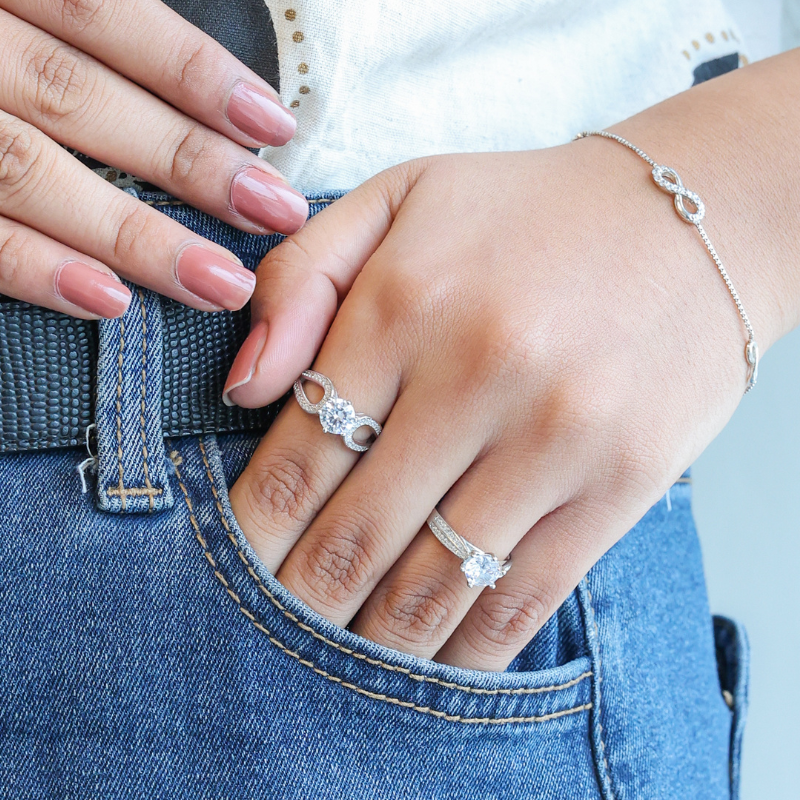Can we wear it while showers ?
Sterling silver jewelry possesses a timeless elegance that makes it a favorite for daily wear. Its characteristic shine and versatility allow pieces to effortlessly transition from casual daytime looks to sophisticated evening attire. It’s no wonder that many jewelry lovers want to keep their favorite sterling silver pieces on all the time—even in the shower.
However, a persistent question plagues owners of this beautiful metal: Can you wear sterling silver in the shower, or does water and soap damage it?
The short answer is nuanced: While getting sterling silver wet will not ruin it instantly, regular and prolonged exposure in the shower will accelerate the natural process of tarnishing and is generally not recommended if you want to maintain its brilliance with minimal effort.
To fully understand this answer, one must delve into the science of sterling silver, the composition of water, and the impact of the common products used during bathing. This complete guide will provide you with the detailed, scientific, and practical information you need to make an informed decision and keep your sterling silver sparkling for years to come.
Part 1: Decoding Sterling Silver – What is 925?
Before assessing its durability in water, we must understand the material itself.
The Composition of Sterling Silver
Pure silver is a noble metal, meaning it is largely non-reactive and highly resistant to corrosion. However, pure silver (99.9% silver) is also very soft and easily scratched or bent, making it impractical for durable jewelry.
Sterling silver, designated as 925 silver, is an alloy created to address this lack of durability. It is composed of 92.5% pure silver and 7.5% of other metals, typically copper. This copper content provides the necessary hardness and resilience for jewelry, but it is also the Achilles' heel when it comes to tarnishing.
The Science of Tarnish (Oxidation)
Tarnish is the dark, dull discoloration that appears on silver over time. Crucially, tarnish is not rust. Rusting occurs when iron-based metals react with oxygen and water; sterling silver does not contain iron and will not rust.
Tarnish is a surface phenomenon caused by a chemical reaction called oxidation. Specifically, the 7.5% copper alloy reacts with sulfur-containing compounds (sulfides) in the air or on the skin to form silver sulfide on the surface. This silver sulfide layer is what gives the jewelry its signature brown, gray, or black appearance.
Tarnish is entirely superficial and does not damage the underlying precious metal, but it certainly diminishes the luster and beauty of the piece.
Part 2: The Shower’s Triple Threat to Sterling Silver
The shower is a complex environment that combines three primary factors known to accelerate the tarnishing process: Water, Heat & Humidity, and Chemicals.
1. Water Quality and Mineral Content
While pure H2O itself is not a major threat to the silver component of the alloy, the water that comes out of your showerhead is rarely pure.
-
Tap Water Minerals: Most municipal water supplies contain trace amounts of minerals, including chlorine and various salts. These compounds can react with the copper alloy in the sterling silver, accelerating the oxidation process and tarnish formation.
-
Hard Water: Homes with "hard water" have higher concentrations of minerals like calcium and magnesium. These minerals can leave residue on the jewelry's surface as the water dries, dulling its shine and creating a film that traps moisture and sulfides, further promoting tarnish.
2. Heat and Humidity
The chemical reactions that cause tarnish are sensitive to temperature.
-
Warm Water: A hot or even comfortably warm shower is the perfect environment for a sped-up chemical reaction. Higher temperatures increase the kinetic energy of the molecules, allowing the copper and sulfides to react more quickly.
-
Steam and Humidity: The bathroom often becomes a highly humid environment during a shower. High moisture levels in the air provide the medium necessary for the sulfur compounds to cling to and react with the silver's surface, accelerating tarnish even after the water stops running. Storing silver in the bathroom itself is often advised against for this very reason.
3. Soaps, Shampoos, and Body Products
Perhaps the greatest threat in the shower comes from the products we use for personal hygiene.
-
Chemical Additives: Shampoos, conditioners, body washes, and bar soaps contain various chemicals—including detergents, surfactants, and fragrances—that can be abrasive or corrosive to metal. These substances can strip away any protective plating or, more directly, react with the copper content.
-
Residue Buildup: Soaps and shampoos are designed to leave a clean feel on the skin, but they can easily leave a sticky, difficult-to-remove residue in the tiny crevices of jewelry, especially rings, intricate chains, and gemstone settings. This residue traps dirt and moisture, creating a perfect micro-environment for corrosion and dulling the sparkle of the piece and any gemstones.
Part 3: The Complete Durability Spectrum – When to Keep it On and When to Take it Off
Sterling silver’s durability is less about an immediate disaster and more about the cumulative effect of poor choices. Here is a spectrum of water-related activities, from safest to most damaging:
| Activity | Risk Level | Rationale | Recommendation |
|---|---|---|---|
| Washing Hands | Low to Moderate | Brief contact with water and mild soap. The danger is usually not the water, but forgetting to dry the piece thoroughly. | Generally Acceptable, but always dry immediately. |
| Showering (Daily) | Moderate to High | Prolonged exposure to hot, steamy water, high humidity, and harsh chemicals in soap/shampoo. This accelerates tarnish significantly. | Strongly NOT Recommended. Remove before showering to prevent frequent cleaning. |
| Occasional/Emergency Shower | Low to Moderate | A rare, one-off instance won't cause immediate damage, but the item must be dried immediately and thoroughly afterward. | Acceptable, but dry immediately. Treat as an exception, not a routine. |
| Swimming in a Pool | Extremely High | High concentrations of chlorine, a powerful corrosive agent. Chlorine reacts strongly with the copper, leading to rapid, severe tarnish and potential pitting of the metal. | NEVER wear sterling silver in a chlorinated pool. |
| Swimming in the Ocean | High | Saltwater contains high concentrations of corrosive salts that can accelerate tarnish and leave residue trapped in settings. | NOT Recommended. Rinse immediately with fresh water and dry if contact occurs. |
| Hot Tubs | Extremely High | Combines the intense heat (accelerated reaction) with high concentrations of chlorine/bromine. | NEVER. The fastest way to cause severe, near-instantaneous tarnishing. |
| Hot Springs/Sulfur Baths | Maximum | Hot springs often contain high levels of sulfur, the primary tarnish-causing agent. The heat speeds up the reaction to the maximum. | Absolutely NEVER. |
A Note on Rhodium Plating
Many high-end sterling silver pieces are rhodium-plated. Rhodium is a member of the platinum family—a hard, highly reflective, and tarnish-resistant white metal.
-
Benefit: A rhodium layer acts as a barrier, protecting the underlying sterling silver from the sulfur and moisture that cause tarnish. Rhodium-plated sterling silver is therefore much more durable and resistant to a quick shower than unplated sterling silver.
-
Limitation: Rhodium plating is thin and wears off over time, especially with friction and exposure to chemicals. Once the plating is breached, the underlying sterling silver will begin to tarnish. Regular showering will hasten the breakdown of this protective layer.
Part 4: The Best Practices for Longevity
If you love the shine of sterling silver and want it to last, removing it before a shower is the easiest and most effective care tip. However, accidents happen, and a lifetime of wear requires a commitment to a few simple maintenance habits.
1. The Instant Fix: Drying is Paramount
If your sterling silver does get wet in the shower or elsewhere, your immediate priority is to dry it completely and immediately.
-
Use a soft, lint-free cloth (like a silver polishing cloth or microfiber towel).
-
Gently pat and wipe the piece, ensuring no moisture is trapped in the clasps, prongs, or filigree.
-
Do not air-dry. Allowing water to evaporate slowly leaves mineral deposits behind, which will dull the finish and encourage tarnish.
2. Storage: The Dry Zone
Where you keep your sterling silver is almost as important as where you wear it.
-
Avoid the Bathroom: The bathroom is a hub of humidity and moisture. Never leave your silver jewelry exposed on a counter or hook in this room.
-
Airtight and Dry: Store your sterling silver in a cool, dark, and dry place. The best method is to use an airtight zip-top bag with the air squeezed out, or dedicated anti-tarnish jewelry pouches or boxes that often contain strips to absorb moisture.
-
Separate Pieces: Store pieces individually to prevent scratching and tangling.
3. Regular Cleaning and Maintenance
Regular, gentle cleaning can combat the slow creep of tarnish and restore luster.
-
Wear It Often: Believe it or not, wearing sterling silver jewelry often can prevent tarnish. The natural oils in your skin act as a barrier and gentle polishing agent, helping to keep the metal bright.
-
Gentle Soap Solution: For regular cleaning, a simple soak in warm water with a few drops of mild, phosphate-free dish soap is effective. Gently brush with a very soft-bristled toothbrush, rinse with clean water, and immediately dry thoroughly.
-
Silver Polishing Cloths: For light tarnish, use a chemically treated silver polishing cloth. These cloths are often dual-sided: one side for removing tarnish and the other for a final polish.
4. Tarnish Removal (When It’s Too Late)
If tarnish has developed, you'll need a stronger solution than simple washing.
-
Silver Cleaner: Use a commercial silver jewelry cleaner, following the instructions precisely. Be cautious with pieces that have gemstones, as some chemicals can damage porous stones like pearls or opals.
-
The Aluminum Foil Method: For severely tarnished pieces, a classic home remedy involves a chemical reaction: Line a bowl with aluminum foil, add a tablespoon of baking soda and a spoonful of salt, place the silver on the foil, and pour hot water over it. The tarnish will transfer from the silver to the foil. Rinse and dry thoroughly afterward. Caution: Do not use this method on oxidized (darkened) silver designs where the tarnish is intentional.
Conclusion: Weighing Risk Against Reward
So, can you wear sterling silver in the shower?
You can, and it won't instantly dissolve. Some pieces may even appear brighter initially as the soap cleans off skin oils and superficial dirt.
However, the question should be rephrased: Should you?
The definitive answer from jewelry experts is no, you should not make a habit of wearing sterling silver in the shower.
Routine exposure to hot, mineral-rich water, high humidity, and corrosive personal care products will inevitably and rapidly accelerate the tarnish process. While tarnish is reversible, constantly having to clean and polish your jewelry not only adds a chore to your routine but also gradually wears down the surface of the metal and any protective platings.
For the longevity, enduring brilliance, and minimal maintenance of your cherished sterling silver jewelry, the 925 rule is simple: Take it off, dry it well, and store it right. A few seconds of removal before you step into the shower is a small investment for a lifetime of beautiful, sparkling silver.









